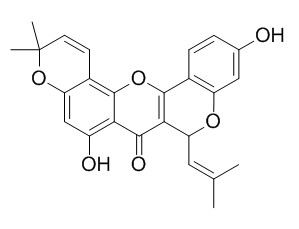Cyclomorusin
Cyclomorusin exhibits competitive inhibition toward monophenolase activity of mushroom tyrosinase, the IC50 value of 0.092 microM. It evokes the stimulation of superoxide anion generation in fMLP-stimulated rat neutrophils. Cyclomorusin , neocyclomorusin and kuwanon C inhibited cholinesterase enzyme in a dose-dependent manner with K(i) values ranging between 3.1 and 37.5 uM and between 1.7 and 19.1 uM against acetylcholinesterase (AChE) and butyrylcholinesterase (BChE) enzymes, respectively.
Inquire / Order:
manager@chemfaces.com
Technical Inquiries:
service@chemfaces.com
Tel:
+86-27-84237783
Fax:
+86-27-84254680
Address:
1 Building, No. 83, CheCheng Rd., Wuhan Economic and Technological Development Zone, Wuhan, Hubei 430056, PRC
Providing storage is as stated on the product vial and the vial is kept tightly sealed, the product can be stored for up to
24 months(2-8C).
Wherever possible, you should prepare and use solutions on the same day. However, if you need to make up stock solutions in advance, we recommend that you store the solution as aliquots in tightly sealed vials at -20C. Generally, these will be useable for up to two weeks. Before use, and prior to opening the vial we recommend that you allow your product to equilibrate to room temperature for at least 1 hour.
Need more advice on solubility, usage and handling? Please email to: service@chemfaces.com
The packaging of the product may have turned upside down during transportation, resulting in the natural compounds adhering to the neck or cap of the vial. take the vial out of its packaging and gently shake to let the compounds fall to the bottom of the vial. for liquid products, centrifuge at 200-500 RPM to gather the liquid at the bottom of the vial. try to avoid loss or contamination during handling.
Korean J. of Horticultural Sci. & Tech. 2017, 793-804
Agronomy2023, 13(9), 2410.
Immunopharmacol Immunotoxicol.2024, 46(4):496-508.
Adaptive Medicine 2020, 12(1): 4-10
Chem Biol Interact.2019, 315:108910
Phytomedicine.2015, 22(11):1027-36
BMC Plant Biol.2022, 22(1):128.
Food Hydrocolloids2024, 156:110345
Front Nutr.2024, 11:1507886
Asian Journal of Chemistry2018, 30(12):2699-2703
Related and Featured Products
J Enzyme Inhib Med Chem. 2008 Dec;23(6):922-30.
Inhibitory effects on mushroom tyrosinase by flavones from the stem barks of Morus lhou (S.) Koidz.[Pubmed:
18608767 ]
METHODS AND RESULTS:
Five flavones displaying tyrosinase inhibitory activity were isolated from the stem barks of Morus lhou (S.) Koidz., a cultivated edible plant. The isolated compounds were identified as mormin (1), Cyclomorusin (2), morusin (3), kuwanon C (4), and norartocarpetin (5). Mormin (1) was characterized as a new flavone possesing a 3-hydroxymethyl-2-butenyl at C-3. The inhibitory potencies of these flavonoids toward monophenolase activity of mushroom tyrosinase were investigated.
CONCLUSIONS:
The IC50 values of compounds 1-5 for monophenolase activity were determined to be 0.088, 0.092, 0.250, 0.135 mM, and 1.2 microM, respectively. Mormin (1), Cyclomorusin (2), kuwanon C (4) and norartocarpetin (5) exhibited competitive inhibition characteristics. Interestingly norartocarpetin (5) showed a time-dependent inhibition against oxidation of L-tyrosine: it also operated under the enzyme isomerization model (k5 = 0.8424 min(-1), k6 = 0.0576 min(-1), K(app)(i) = 1.354 microM).
J Agric Food Chem. 2005 May 18;53(10):3867-71.
Antiinflammatory flavonoids from Artocarpus heterophyllus and Artocarpus communis.[Pubmed:
15884809 ]
METHODS AND RESULTS:
The antiinflammatory activities of the isolated flavonoids, including cycloartomunin (1), Cyclomorusin (2), dihydrocycloartomunin (3), dihydroisocycloartomunin (4), cudraflavone A (5), cyclocommunin (6), and artomunoxanthone (7), and cycloheterohyllin (8), artonins A (9) and B (10), artocarpanone (11), artocarpanone A (12), and heteroflavanones A (13), B (14), and C (15) from Artocarpus communis and A. heterophyllus, were assessed in vitro by determining their inhibitory effects on the chemical mediators released from mast cells, neutrophils, and macrophages.
CONCLUSIONS:
Compound 4 significantly inhibited the release of beta-glucuronidase and histamine from rat peritoneal mast cells stimulated with P-methoxy-N-methylphenethylamine (compound 48/80). Compound 11 significantly inhibited the release of lysozyme from rat neutrophils stimulated with formyl-Met-Leu-Phe (fMLP). Compounds 8, 10, and 11 significantly inhibited superoxide anion formation in fMLP-stimulated rat neutrophils while compounds 2, 3, 5, and 6 evoked the stimulation of superoxide anion generation. Compound 11 exhibited significant inhibitory effect on NO production and iNOS protein expression in RAW 264.7 cells. The potent inhibitory effect of compound 11 on NO production in lipopolysaccharide (LPS)-activated macrophages, probably through the suppression of iNOS protein expression.
Arch Pharm Res. 2015 May 16.
Isoprenylated flavonoids from the root bark of Morus alba and their hepatoprotective and neuroprotective activities.[Pubmed:
25981820]
METHODS AND RESULTS:
A new isoprenylated flavonoid, 2S-5,7,2',4'-tetrahydroxy-3',5'-di-(γ,γ-dimethylallyl)flavanone, sanggenol Q (1), along with seven known isoprenylated flavonoids, sanggenol A (2), sanggenol L (3), kuwanon T (4), Cyclomorusin (5), sanggenon F (6), sanggenol O (7), and sanggenon N (8), three known Diels-Alder type adducts, sanggenon G (9), mulberrofuran G (10), and mulberrofuran C (11), and a known benzofuran, moracin E (12), were isolated from the root bark of Morus alba using silica gel, ODS, and Sephadex LH-20 column chromatography.



